One of the main draws of having a pickup truck is being able to both carry and pull cargo. Every truck, however, does have limitations on how much it can carry and tow.
Towing capacity is the amount a truck can pull behind its car and is calculated in its simplest form by:
Towing Capacity = GCWR – Curb Weight
If you want to find the towing capacity at any given point in time, you need to take into account other factors and use the following equation:
Towing Capacity = GCWR – Passenger Weight – Cargo Weight – Curb Weight – Customization Weight
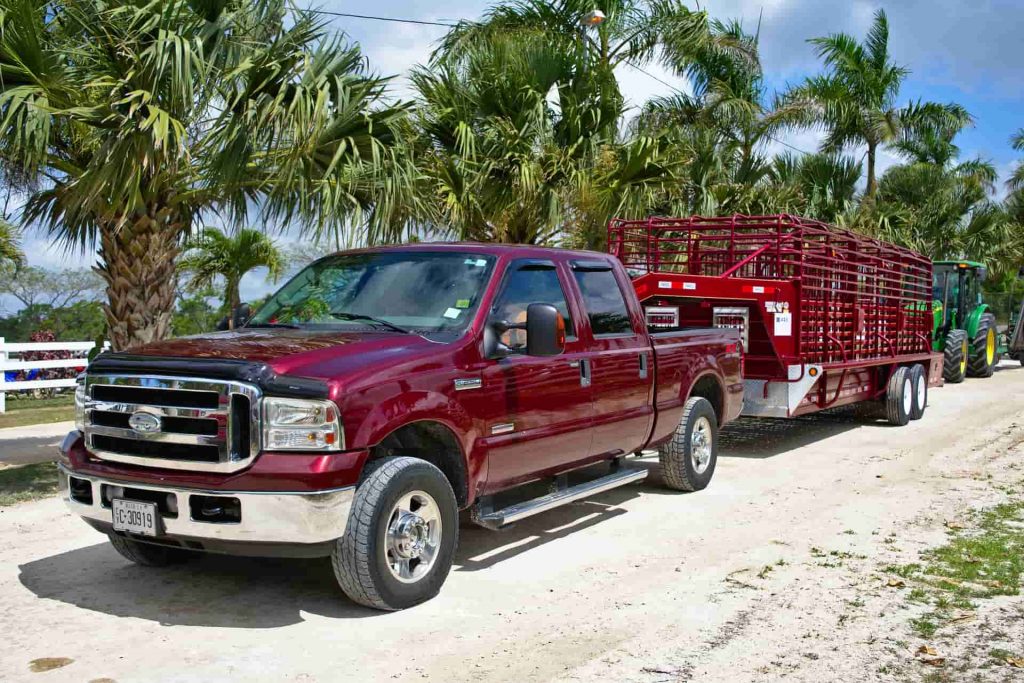
What is Towing Capacity?
Towing capacity is the amount of weight that a truck can safely pull behind a truck through a hitch. Usually, it is displayed as the total value of the trailer.
It is important to recognize that towing capacity is not the same for all types of trucks. There are many factors that impact towing capacity. These are:
- Engine
- Body
- Manufacturer
- Internal Structure
It is important to know your truck’s towing capacity because exceeding these limits can cause damage to the truck as well as significant safety concerns.
Though the towing capacity of a single truck has many factors, it also depends on other personal factors.
The way towing capacity is calculated is that it takes into account the weights of what is also in the truck. This means that any passengers, customization weight, and cargo can impact the towing capacity of your truck.
How is Towing Capacity Calculated?
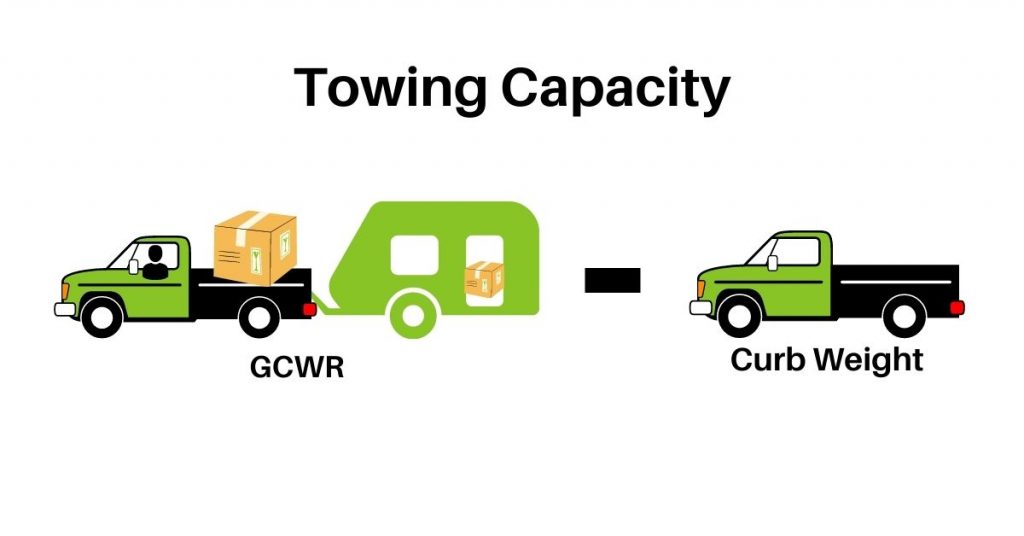
Maximum towing capacity is based on the value called the GCWR.
The GCWR is the gross combined weight rating. It is a number provided by a manufacturer that states the maximum weight that both the truck and the trailer can weigh.
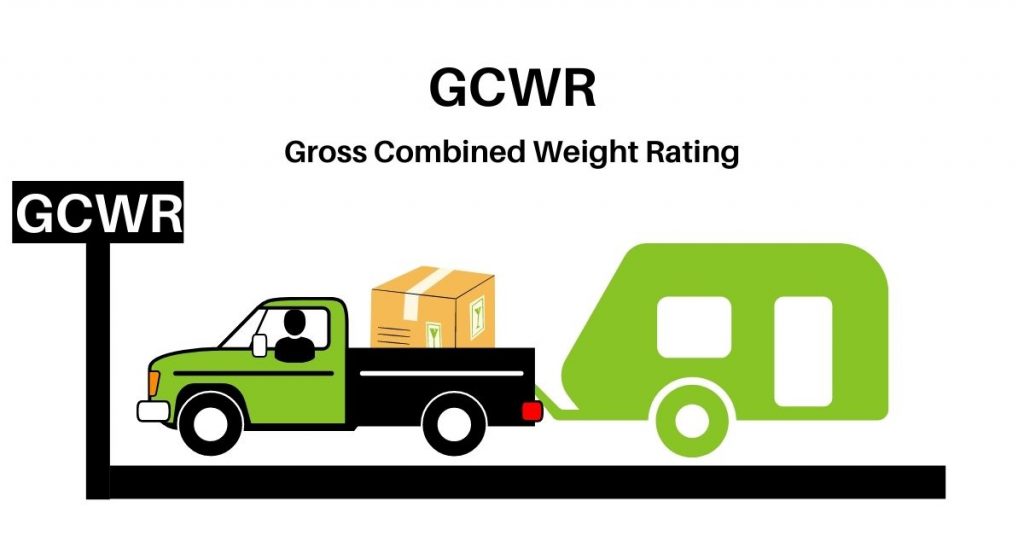
This means that the total weight of the truck, passengers, cargo, and trailer (with cargo) cannot exceed the GCWR.
So in order to calculate the actual amount that a truck can tow, you need to subtract the truck weight, passenger weight, and cargo from the GCWR.
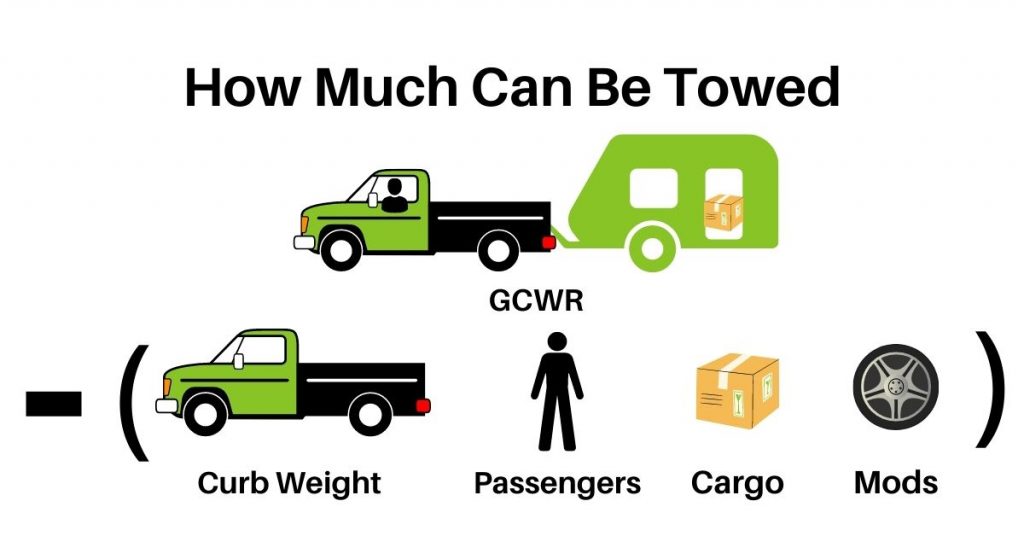
The passenger weight is simply the weight of the driver and any other passengers.
The cargo weight is the weight of everything being carried either in the truck bed or cabin.
The curb weight is the stock value weight of a truck. It provides a weight rating from the manufacturer that states how much the truck weighs in its base form with a full tank of gas.
If the truck is customized in any way (lift kits, suspensions, roof racks, toppers, covers, lights) this weight needs to be adjusted to determine the most accurate the towing capacity.
It can be difficult when replacing parts to know the exact changes, but typically a couple pound difference won’t be a problem, but for any major change that alters the weight by over 10 pounds, this should be accounted for in the customization weight.
Amount a Truck Can Tow = GCWR – Passenger Weight – Cargo Weight – Curb Weight – Customization Weight
One thing that people often forget, however, is that there is one more calculation that needs to be made to ensure safe transport.
This is relating the towing capacity to the payload capacity.
What is the payload capacity?
Payload capacity refers to the amount of weight that a truck can carry, rather than tow. It is essentially the maximum weight that can go on a truck.
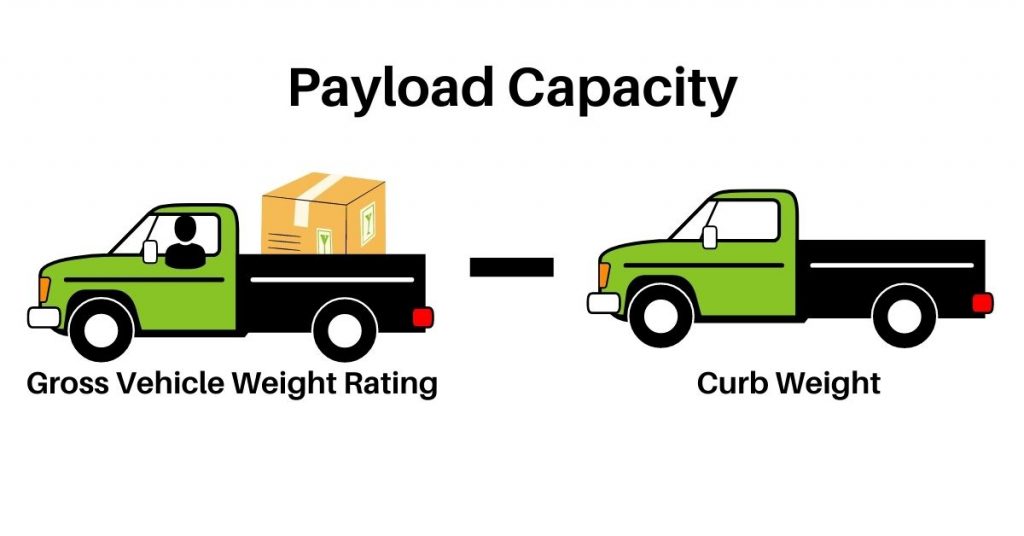
Ever heard of a half-ton, quarter-ton, or one-ton truck? These refer to the payload capacities of the truck.
So the payload capacity includes all of the weight that gets put on a truck.
This means that the weight of the passengers, cargo, customization, and tongue weight cannot exceed the payload capacity.
Many truck drivers forget to include the tongue weight in this calculation.
Why this is important to towing capacity is that you may calculate that your truck can pull a 2000 lbs trailer, but forget that the corresponding tongue weight might run you over the limit.
For more information on payload capacity and how it relates to trucks today, READ HERE!
How Tongue Weight Impacts Towing Capacity
Tongue weight refers to the amount of weight that is exerted on a truck by the trailer on the hitch.
It is recommended that the tongue weight of a trailer is 10-15% of the total trailer weight.
Tongue weight is important because it not only affects how much weight is placed on the truck, but impacts handling.
This video is a great visual of how improper trailer balancing causes safety and control concerns.
Not only is tongue weight important for control, but it also can impact the payload.
For more in-depth information read What is Trailer Tongue Weight?
This is best explained through an example:
| GVWR | 5,500 |
| Curb weight | 4,000 |
| GCWR | 9,500 |
| Passenger Weight | 300 |
| Cargo Weight | 400 |
| Customization Weight | 150 |
Towing capacity: 9500 – 4000 – 300 – 400 – 150 = 4,650
Payload Capacity = 5500 – 4000 = 1,500
Payload = 300 + 400 + 150 + (0.15*4650) = 1,547.5
The payload with this towing capacity assuming a tongue weight of 15% of the trailer would exceed the payload capacity of the truck. To then calculate the towing capacity from there, we would need to determine the weight of the trailer that would not exceed a payload of 1,500.
Payload = 300 + 400 + 150 + (0.15*Trailer Weight) = 1500
This would give a max towing capacity of 4,333 (with 15% tongue weight).
However, with a 10% tongue weight, the weight would not exceed the payload capacity.
This is why it is important to consider both the payload capacity and the towing capacity when determining the actual safe towing weight.
Towing Capacity Calculator
Below though can find the towing capacity calculator that will help you determine the amount that your truck can tow with the provided GCWR.
But don’t stop there! Make sure you take the calculated tongue weight and use it in the following calculator to see if your truck exceeds its payload capacity to make sure you are driving safely.
What is GCWR vs GVWR vs GAWR?
GCWR and GVWR are two common terms that most truck owners are familiar with if they lug around cargo.
GCWR stands for Gross Combined Weight Rating and is used to determine the towing capacity of a truck.
GVWR stands for Gross Vehicle Weight Rating and determines the amount of cargo that a truck can carry.
Read GCWR vs GVWR for examples and a more detailed description between the two.
GAWR is also something that you need to keep in mind when towing. GAWR stands for Gross Axle Weight Rating. This is the maximum amount of weight that can be put on an individual axle.
This is similar to GVWR and is usually located in the same place (such as the certification label on the inside of the driver’s side door).
This is the most difficult to measure because it requires isolating each axle rating. Any time you suspect you are going to reach the max for any of these values, it is recommended that you check the GAWR as well.
Towing Capacity vs Carrying Capacity
Any truck that has too much weight can face major safety issues. A car that tows too much could break. A truck that carries too much may not be able to be controlled.
Both knowing how much a truck can carry and a truck can tow is critical for the appropriate functionality of a truck.
Towing Capacity is calculated from the GCWR and the carrying capacity (also known as payload capacity) is calculated from the GVWR.
In both instances, you need to subtract the curb weight to calculate the towing and payload capacity.
However, you must also subtract the weight of the passengers, cargo, and any additional custom parts to determine the real value of both.
Carrying capacity is a simple name for payload capacity.
Can Towing Capacity be increased?
There is an opportunity to increase towing capacity by making changes to the structure, engine, transmission, axles, brakes, etc.
This should only be done and evaluated by a professional who knows the impact of the changes. You always want to make sure that you take into account any changes you make to your vehicle and how that can impact towing.
In most cars, adding lifts or other cosmetic changes, this will have a negative impact on the towing capacity of your vehicle.
If you know you need lots of towing capacity, it is safest to get a vehicle from the manufacturer that has the capabilities you desire.
As with any modifications to a truck, there is a higher potential for error and makes it more difficult to determine the exact numerical impact of the change to the towing capacity.
Conclusion
Towing capacity is calculated by subtracting the curb weight of a vehicle from the GCWR.
It is important to remember that this calculates the maximum towing capacity of your vehicle. If you want to calculate how much you can actually tow at a given moment, you need to account for passengers and cargo.
No matter what you are towing, you need to ensure you are being safe. If you do not exceed the GCWR you are only part of the way there. You need to make sure that you are not exceeding the payload capacity of your truck as well.
You also need to distribute the weight of your trailer accordingly. The safest distribution is to have 10-15% of the trailer weight exerted on the tongue. This will help you calculate the payload of your truck and create safer driving conditions.
If you don’t have a tongue weight scale and you ever plan to tow, you really should get one.
Grab your tongue weight scale today and tow safe!
Please share this article with anybody who does a lot of towing! We want to make sure you are all driving safely and know how to properly calculate towing capacity.



I have a 2012 Dodge Ram Laramie with the 5.7 4/4 crew cab short box . My GVW 6700 lbs(3040Kg) .To be safe I should not exceed my capacity understood. The reason I ask is some fifth wheels say half ton series. So I do not want to toast my transmission . What would you recommend ? Thanks Chris